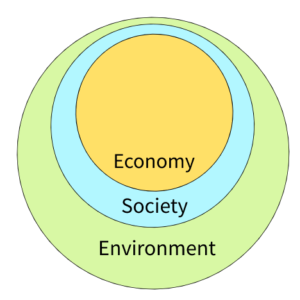Sustainable Creativity
Now more than ever, it is important to pay attention to the impact you have as an individual. Your own ecological footprint may seem insignificant but when adding all the individual footprints, even in just one city, the impact grows immensely. Put simply, an ecological footprint is a measure of human impact on nature which considers aspects such as housing, transportation, and energy consumption. The ecological footprint of Canada is approximately 8.17 hectares, one of the highest countries in the world. This means that if everyone lived like us, we would need over 8 more planets to sustain us.
It is important to think of the individual impact you have in all areas of your life, even with your creative endeavours! Whatever kind of creative projects you are working on, try to keep in mind the impact you are making within your activity, the materials you use, and the measures you take for your creations.
Obtaining Sustainability
 Sustainability encompasses three main categories: economy, environment, and society. Each of these categories is crucial to obtaining a balanced and healthy network of interconnecting pieces. In the past, they were seen as three separate ‘pillars’ but it is now known that they are all encompassing. Environment encompasses both economy and society as without a healthy and livable environment, the other two simply cannot exist. Society it next, because without healthy social aspects, economies would collapse. Lastly, economy is in the center as the other two do not necessarily need economy to survive and have proven so in the past.
Sustainability encompasses three main categories: economy, environment, and society. Each of these categories is crucial to obtaining a balanced and healthy network of interconnecting pieces. In the past, they were seen as three separate ‘pillars’ but it is now known that they are all encompassing. Environment encompasses both economy and society as without a healthy and livable environment, the other two simply cannot exist. Society it next, because without healthy social aspects, economies would collapse. Lastly, economy is in the center as the other two do not necessarily need economy to survive and have proven so in the past.
Whether you are cooking, painting, composing music, or designing – always keep in mind this encompassing vision of sustainability into your own lifestyle and creativity. Whatever the size of your project, sustainability can play a role. With the knowledge of this circled around our community, it is fairly easy to live and create in a sustainable way. Listed below are some tips to help you on your way.
Tips for Sustainability:
- Buy ethically made products
Pay close attention to where products are made and do research on companies and businesses before hand. It is easy to find information on the sustainability of a company on the internet. Check out the factory and workplace information, ethical recognized certifications such as fair trade and B-Corp, as well as material sourcing information.
- Ecological Footprint
Paying attention to your ecological footprint encompasses many things as a means to become more sustainable. Try to focus on things such as how you get your products, where they come from, and what ingredients are inside. When considering your energy consumption, try to always unplug anything from power sockets and turn off lights to conserve energy.
When considering your carbon footprint, remember that driving spends more carbon than taking public transportation. Also note that buying good from overseas also spends more carbon than purchasing from your own country.
- Reduce, Reuse, Recycle
There are plenty of products out there that end up in second-hand stores. Why not browse the aisles here for items and material that can be repurposed for your own projects? Not only are you taking a step towards environmental consciousness, but the items are generally going to be a lot cheaper than buying brand new!
- Go Eco Friendly

When creating something, try to think of the future for the product. Is it biodegradable or will it end up in the landfill? Is it organic or full of toxic matter? When making the decision to step away from environmentally harmful products and materials, you are not only making the decision to care for the planet but also care for the people wearing/purchasing your products.
- Shop local
Shopping local is a perfect example to encompass all sustainable categories. By purchasing local products, you are helping the environment by means of reducing carbon outputs from shipping. Socially, you are helping your local community and small businesses that will be grateful for your service rather than big box stores. Economically, you are putting money back into your own community and therefore helping the local economy.
Sustainable Future
Whether small changes or big changes, taking the steps to become more sustainable is an important piece to caring for the future of our planet and our communities. There are plenty more ways to reduce your impact and step towards sustainable creativity. All it takes is a little extra research and mindfulness to create something that is low impact and environmentally friendly!
If you are looking for a little extra inspiration, we have some amazing sustainable creatives here with Maker Faire Saskatoon! So far on the blog, we have spotlighted a couple Makers who are setting the stage for sustainable creativity. Amanda Bosiak makes handmade soaps in her house focusing on natural products such as essential oils. Hugo Jamain makes handmade jewelry from recycled materials in his shop that would otherwise end up in the landfill!
If you are interested in learning what your ecological footprint is, take the test here!
